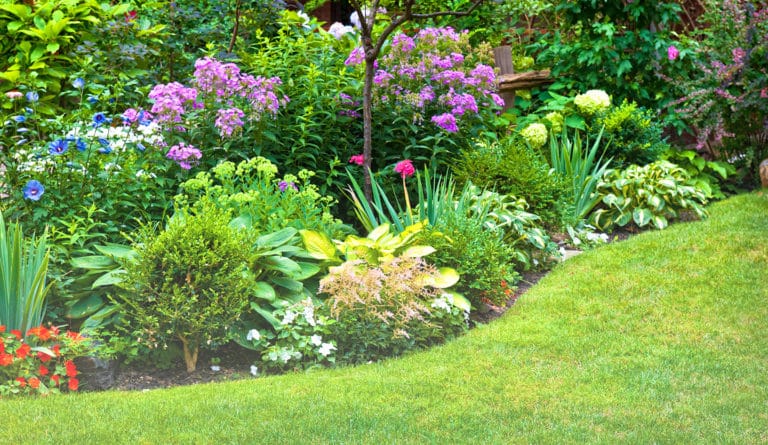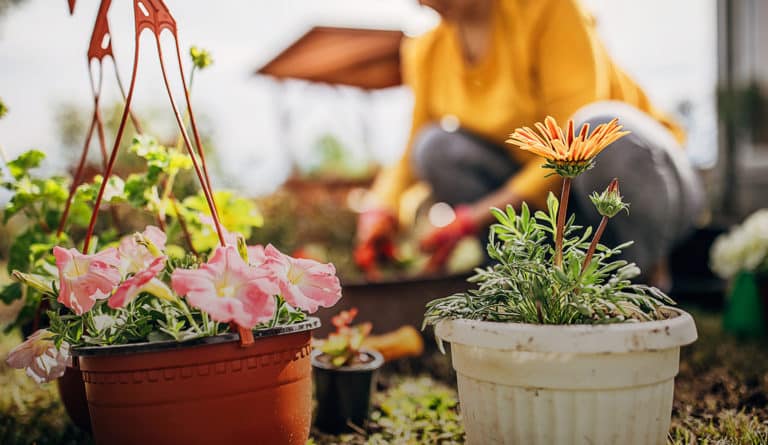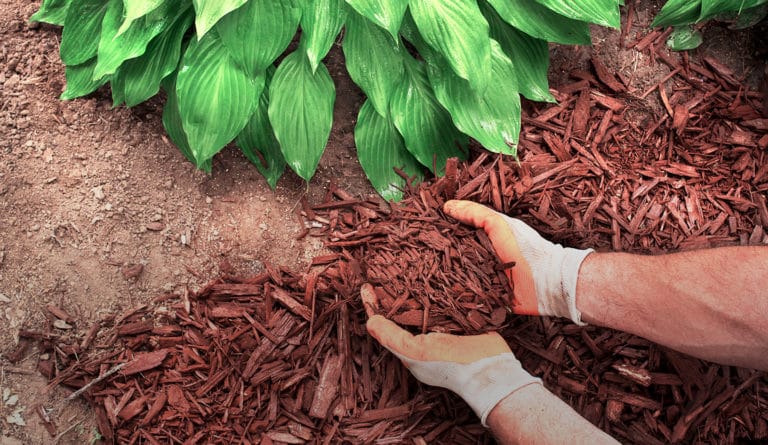- Pine
- Cedar
- Fir
- Oregonia
- Birch Poles
- Ilex Berries
- Curly Willow
- Miracle-Gro Potting Soil
- Pot liners/ Container
- Fairy Lights
- Accents & Decor
- Jumbo Christmas Lights
- Pine cones
- Wooden dowl
- Floral Tape
- Floral Wire
- Diagonal cutters/ tin snips/ needle nose clippers/ or flower sheers
Hello Everyone! My name is Shavonne, and you can find me anywhere on social media under the name Once Upon a Bungalow. Plant Project Canada has graciously asked me back to give you some tips on creating outdoor holiday arrangements. Now, I’ll be honest with you, this was my first time making an outdoor arrangement. I’m not claiming to be an expert. I am, however, going to show you everything I learned, along with the materials I used to make these as quirky and unique as possible – a common theme in our bungalow. Be sure to check out this holiday outdoor arrangement reel on Instagram, Facebook, or Tiktok!
Alright, let’s go!
First things first: If you don’t know how to do something, ask someone who does! That’s precisely how I started this project, asking our local expert so that I could give you the best “how-to” article possible. I’d love to give a HUGE shout-out to Jacqueline Williams of Just a Girl in her Garden, a local greenhouse and flower shop. She took the time out of her busy holiday schedule to give me a course on how to create a long-lasting and gorgeous arrangement for our cold Saskatchewan winters. Check out Just a Girl in Her Garden’s webpage here.



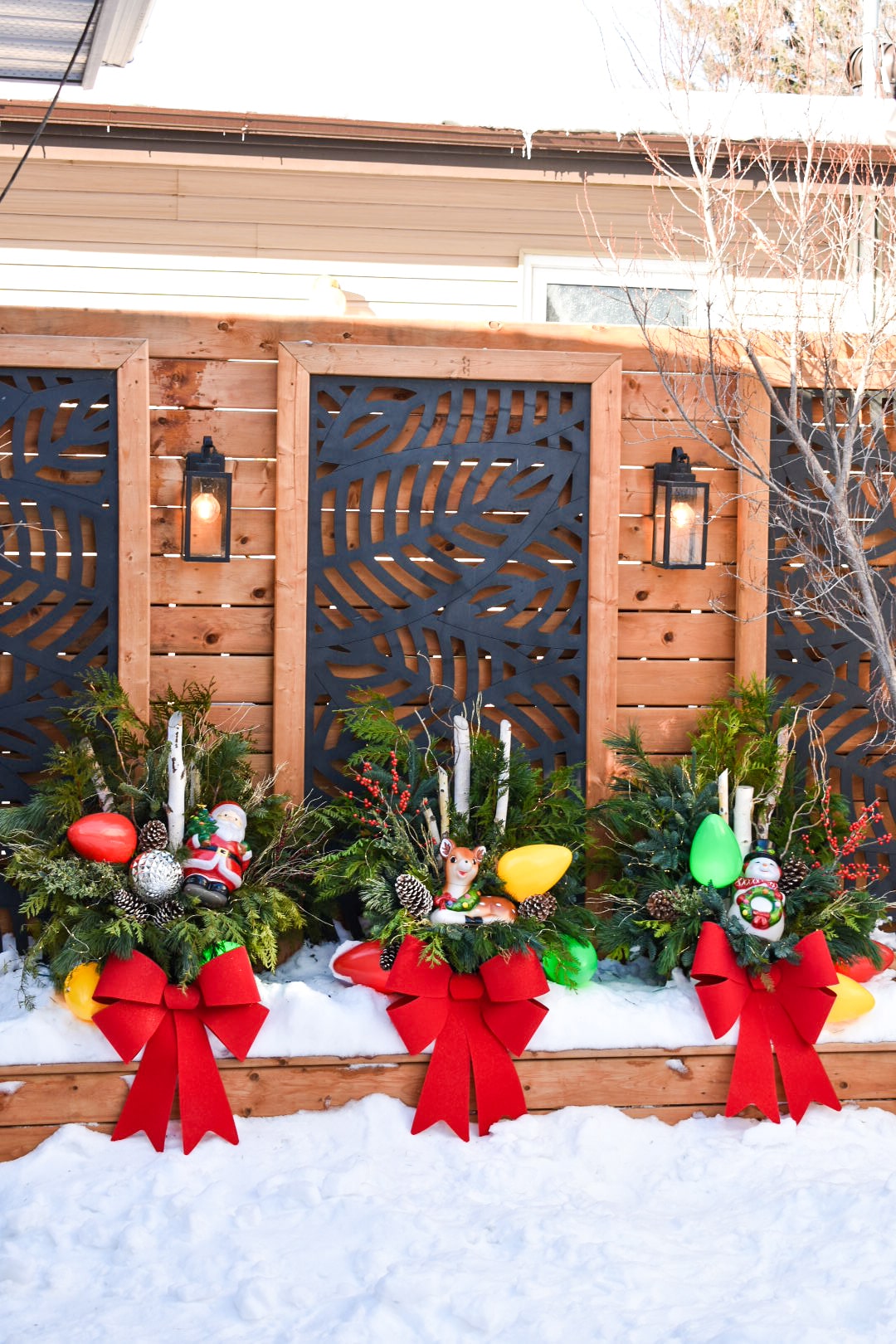
step 1.
Select you greens: I used three main foliage types for the arrangements (photographed above in order): Pine, Cedar, and Fir. Using different kinds of foliage gives the arrangement different colours, textures, and dimensions. I purchased an equal amount of each of these varieties, and I recommend you source your foliage from your local greenhouse to ensure the quality of the product. If you already have a garden full of these greens, you can also just cut off your own!



For accents, I used Oregonia, birch poles, and Ilex berries. These are more of an investment; however, you only need a few of them, and they add so much flair and personality to your arrangement. Later in this article, I’ll also show you the curly willow that is incorporated into the final design.



step 2.
Select you soil, pot, and decide on a layout: There are many options that can be used as a basis for the arrangement. Some prefer sand, and some prefer floral foam; however, in the harsh Saskatchewan climate that fluctuates regularly and sees extremely cold temperatures, our local garden expert, Jacqueline, recommended starting with the soil. I chose to use Miracle-Gro Potting Mix, which is ideal for outdoor and indoor containers. This will also help us prevent the branches from rotting and ensure we have a long-lasting holiday arrangement. This potting mix facilitates soil aeration that ensures oxygen reaches the plant branches, which is an essential factor in promoting overall arrangement health.
Your pot selection depends on the size of your arrangement and whether or not you would like to use a liner in your main pot. These three arrangements were going to be featured in our outdoor privacy wall planter, so I knew just the pot liner would work well for this project. You can also choose to build your arrangement directly into your main pot; a liner is unnecessary.
Deciding on your arrangement layout depends on how you want people to view it. Where is your arrangement going? Will it be seen by all the sides? Or will it only be seen from the front? Asking yourself these questions will determine how you build your design. For my vintage holiday arrangements, I knew there would be a backside that would rest against the privacy wall in our backyard. Instead of a “mound” style that is beautiful from all angles, I went for a forward-facing arrangement that will be primarily viewed from the front. Knowing my design direction, the back of my arrangement didn’t have to look good, and I could create height at the back of the pot instead of the middle. Tip: Explore Pinterest for inspiration before beginning.



step 3.
Start with the poles: Start with your birch poles. I used three as I like an odd number, but you can use as many as you like! This creates a central focus for your arrangement, and you can start building the rest from there. Stagger the poles to create different heights and vary the angles at which they are added to the pot. Remember, if you are building a mound arrangement (an arrangement that will be viewed from all angles), you will want to place these in the center. However, these were placed more toward the back because I am building a forward-facing arrangement.



step 4.
Add the greens: One of the biggest things I learned from my class at Just a Girl in Her Garden was to make sure that you take off the lower branches, needles, and leaves from the base of your foliage to ensure that the plant does not rot within the soil. Before placing it in the pot, ensure the bottom 3-4 inches are clear of all needles, leaves, and branches. Some you can remove with your hands, and others can use either tin snips, floral sheers, diagonal cutters, or needle nose clippers.




step 5.
Add the accents: Take into consideration what you want in the center of your arrangement. I knew that I wanted the vintage Santa, reindeer, and snowman as my focal point, so I included parts of the shorter greenery facing downwards in the front to create a resting spot for these elements. After putting all the fir, pine, and cedar in place, I added some curly willow, glitter branches and pine cones. To attach your accent items and focal point items, use floral wire and wrap the wire around the item you would like to secure, and then anchor the wire to a birch pole, or another strong point of your foliage. This keeps everything secure and in place.




step 6.
Add the lighting: Next, I added the Ilex berries, jumbo-size Christmas lights and fairy lights. The lights do make all the difference! These fairy lights were battery operated, but I recommend getting plug-in lighting or solar lighting that you can set to come on when it gets dark out at night – it’s just less hassle.




step 7.
Water your arrangement: After completing all these steps, ensure you water your arrangement well; however, do not overwater. If you accidentally put too much water in the soil (like I did), drain it out before putting it outside to freeze. If you fail to do this and have too much water in the pot, the plastic can burst open with the expansion of the frozen water! Remember, if temperatures go above zero, you must water these arrangements often! They do drink quite a bit. If temperatures stay below zero, they should remain lovely, lush, and green, and you won’t have to worry about watering.
ta-da! you’re done!
Honestly, I was pretty worried about messing up before I started making these! As it would turn out, you really can’t mess up! Have fun with it, get creative and add finishing touches that make your arrangement represent what makes you happy and brings you joy. I went for an over-the-top, vintage, quirky Christmas, and I’m so glad I did. I hope you guys enjoyed this tutorial! Happy Holidays from my family to yours! – Shavonne
Follow Shavonne on Instagram and TikTok






#happycreating!
We have some spook-tacular Halloween crafts that are sure to haunt your home with fun and festivity! Whether you’re aiming to add a ghostly charm to your indoor plants with a Ghost Vase or a chilling ambiance to your front porch with Creepy Planters, each project is a blend of creativity and delight. Perfect for all ages, these crafts invite you to embrace the playful spirit of Halloween. So, gather your supplies, summon your imagination, and let the Halloween crafting commence!
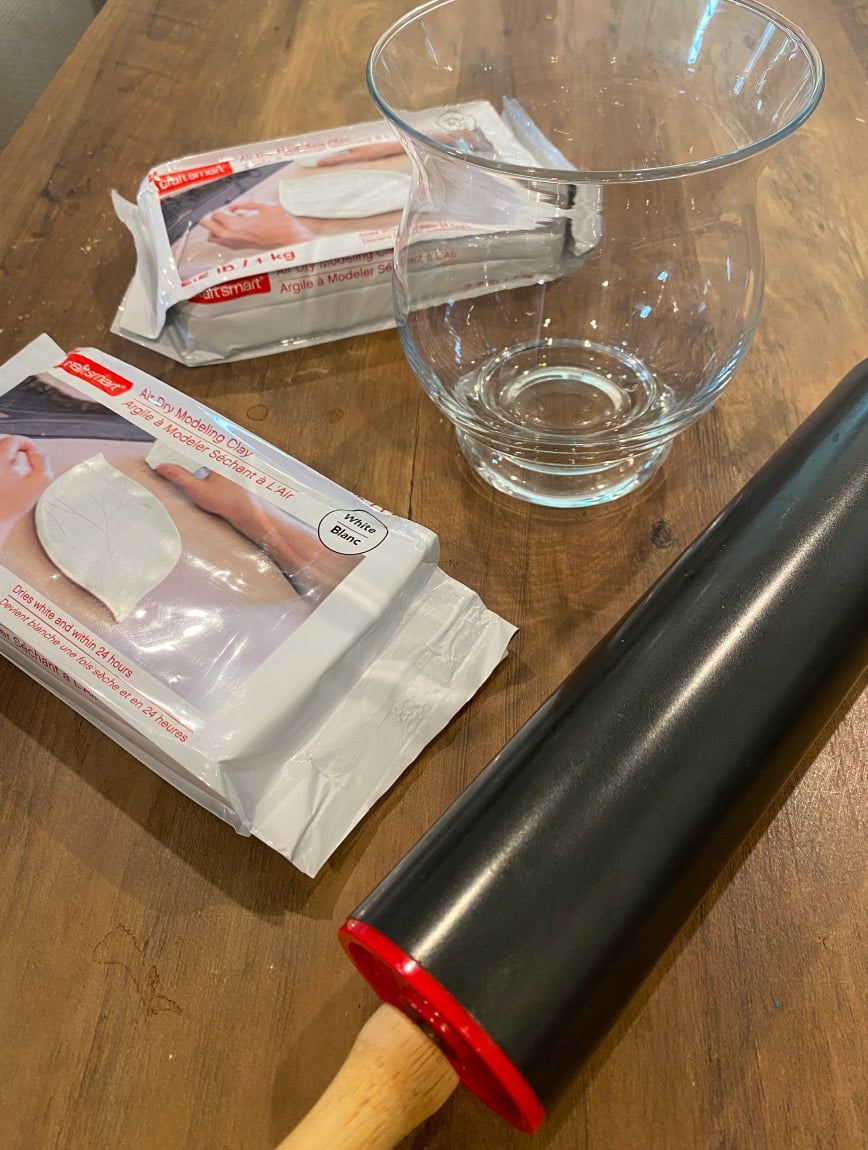
Ghost Vase
What You’ll Need
- Air dry sculpting clay
- A vase
- Paint – Grey or White (or any colour you can imagine!)
Directions
- Pop in some flowers, add water, and enjoy your spooky floral arrangement with blooms from your garden!
- Roll out your clay into a nice, even slab. It should be a little longer than the vase’s circumference. Cut it into a neat rectangle with straight edges at the top and bottom. Bonus points if it’s tapered so it flares out at the bottom like a ghostly skirt!
- Shape it around the vase. Try to keep it wider at the bottom to mimic loose fabric.
- Peek-a-boo! Cut eye holes into the clay so you can see the vase and your ghost can keep a watchful gaze on your guests.
- Optional: Leave your ghost au naturel or add a layer of paint for that extra cloth-like feel.


Ghost Garland
What You’ll Need
- A variety of yarns in different colours
- Yarn for hanging (macrame yarn or fishing wire works great)
- Felt for spooky eyes
- A clean toilet paper roll
Directions
- Cut your hanging yarn to the length you want your ghostly garland to be.
- Flatten your toilet paper roll
- Choose a yarn colour and wrap it around the roll about 30 times or until desired thickness.
- Tie the top of your yarn using the same colour and cut the yarn at the bottom where the toilet paper roll ends.
- Place your yarn pieces on the yarn used for the garland so where you tied it together is sitting on the garland yarn. Fold the top section of yarn over garland yarn. Using another piece of yarn (Same color as your ‘ghost’) wrap around the ghost and tie to create the head.
- Repeat the process until you’ve got a full ghostly gang!
- Cut out eye shapes from your felt (pro tip: use a hole punch for quick circles). Glue the eyes to your ghosts. We only added eyes to the white ones—let the others be mysterious Halloween pom-poms.
- Hang your spooky creation and enjoy!

Cheese Cloth Ghost
What You’ll Need:
- Cheese cloth or any white fabric at hand
- Balloons
- Various cups, vases, or bottles
- Modge Podge or school glue
- Black felt
- Optional: Battery-operated lights for extra spookiness
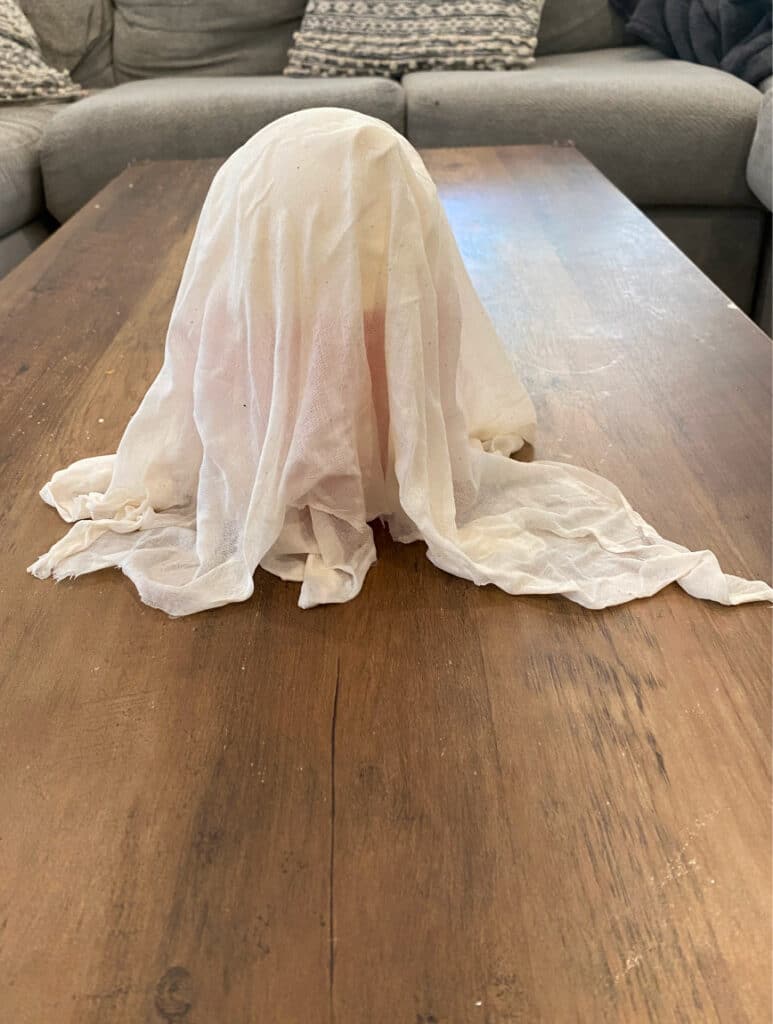
Directions
- Mix equal parts of Modge Podge or glue with water in a big container. Warning: it’s messy, so maybe use something disposable!
- Blow up your balloon to the size of your future ghost’s head and sit it atop a cup or vase of your desired height. Cut your cheese cloth to drape over the balloon and spill onto the ground.
- Drench the cheese cloth in the gluey mixture, squeeze out the extra goop, and drape it over your balloon and cup.
- Let your ghost dry overnight or for a solid 12-24 hours.
- Once dry, remove the cup, pop the balloon, and set your ghost free!
- Cut out eyes and mouths from felt and glue them on.
- Optional: Pop some battery lights inside for a haunting glow. Try different sizes for versatile spookiness: tall for doorways, small for tables, or hang them!


Plant Eyes
What You’ll Need:
- Cheese cloth or any white fabric at hand
- Balloons
- Various cups, vases, or bottles
- Modge Podge or school glue
- Black felt
- Optional: Battery-operated lights for extra spookiness
Directions
- Paint large, eerie black circles on each Styrofoam piece (or get creative with colours, glow-in-the-dark effects, or creepy veins). Tip: trace something round to draw circle before painting.
- Stick a wooden stake into the Styrofoam or glue it on for stability.
- Nestle these eerie eyes into your plants or bushes for a peeping effect!
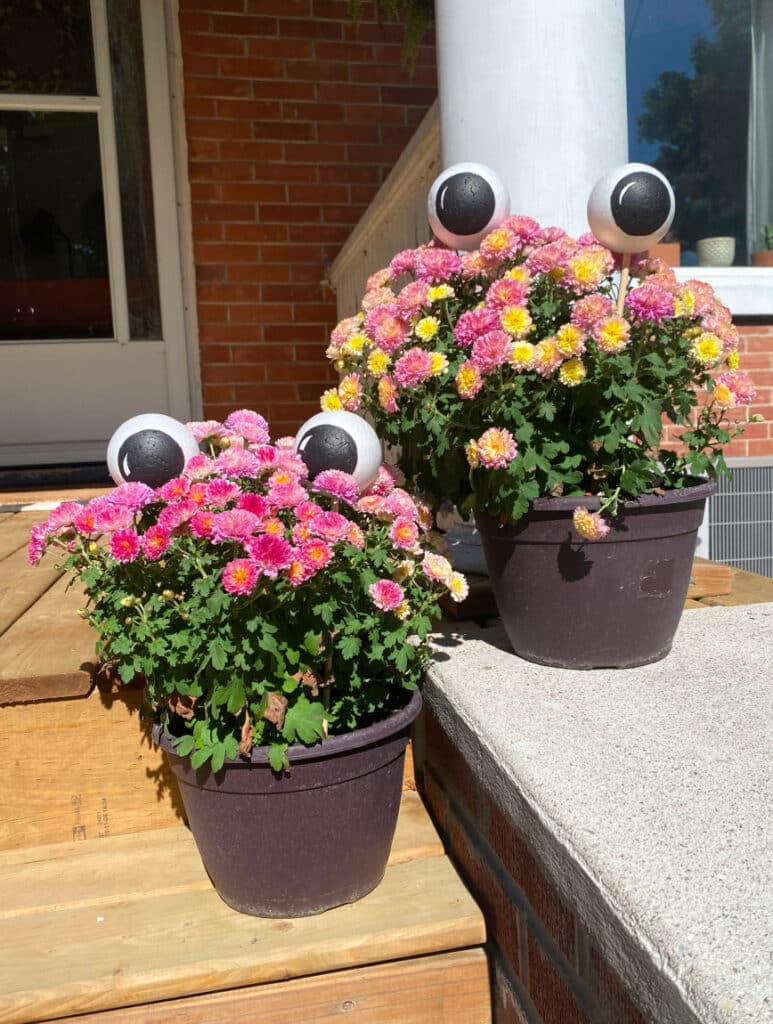
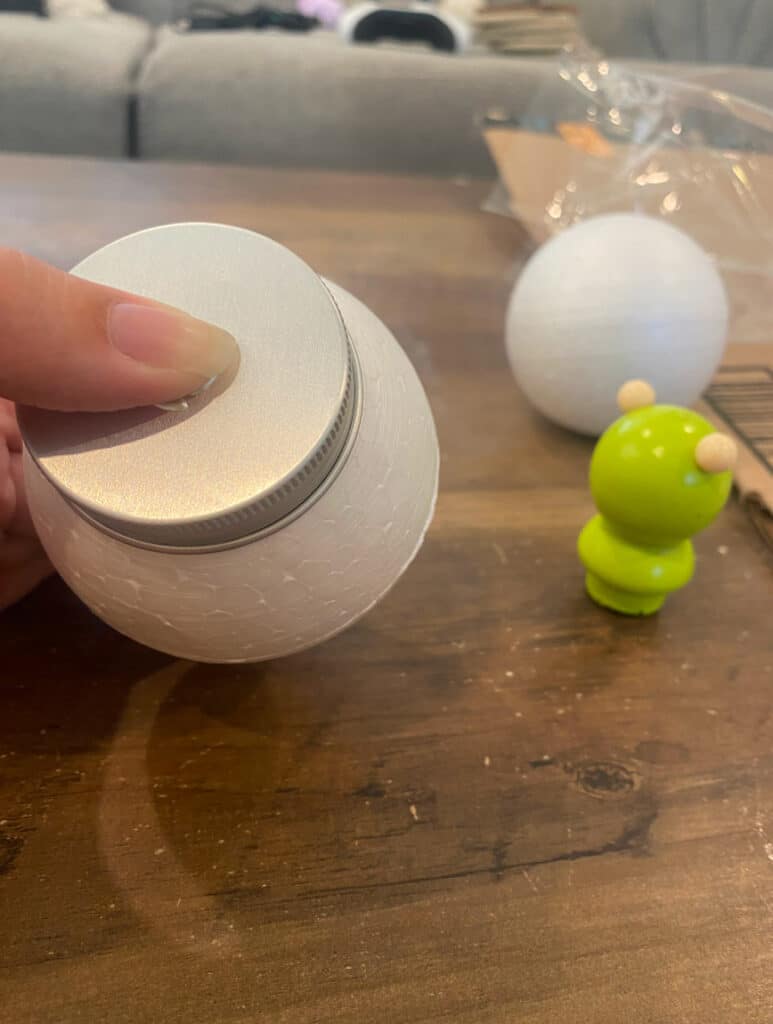

Creepy Planters
What You’ll Need:
- Planters
- Plastic spiders or other creepy crawlies
- Chalk paint
- Glue (a glue stick will do)

Directions
- Glue your creepy critters onto the planters.
- Paint over the planters and bugs with chalk paint (other paints work, but chalk paint sticks better, especially if your planters are shiny).
- Style with plants and watch your creepy creations come to life!

#happycreating!
Looking for a fun and sustainable way to store your freshly grown fruits and veggies? Use our DIY easy macramé produce net!
Not only will you end up with a chic, eco-friendly storage solution, but you’ll also get the satisfaction of creating something beautiful. Perfect for beginners and craft enthusiasts alike, this project promises to add a touch of handmade charm to your kitchen or pantry.

Here’s what you’ll need:
-
3mm Macrame Yarn
-
Scissors
-
Masking Tape
step 1
Cut macrame yarn into 8 pieces measuring about 120” long. You can tape the ends of the yarn to avoid the yarn from fraying.

step 2
Gather the 8 pieces cords and find the center. Create the handle by making a vertical row of Square Knots. Tie the Square Knots with 4 cords grouped together in the middle, 2 cords on the left, and 2 cords on the right. Make 18 vertical Square Knots to make the handle.

step 3
Tape the handle to the top of a slender water bottle. This can help to make a form for the bag’s shape. Then take two cords from each handle and tied them together in a Square Knot. Make sure you don’t space out the rows too much, keep them as close and as tights as possible.
step 4
After the rows of Square Knots reach the bottom of the water bottle, un-tape the handle and gently pull the bag up. Re-tape and continue making more Square Knots. Do this until you reach your desired length of the bag.
step 5
When finished weaving the body, make a Wrapping Knot. Trim the tassel to your desired length and fray. Start filling your produce bag with veggies or fruit of your choosing!

#happycreating!
These delightful DIY flower-shaped seed bombs are an ideal gift for Mother’s Day.
Show your appreciation for MOM by using your imagination and customize with your favourite shapes or colours!


Here’s what you’ll need to get started and create these plantable treasures:
Tools:
- Blender
Materials:
- 1 packet of your chosen seeds
- 1 sheet of your favourite coloured paper
- 1 silicone mould in the form of flowers or any design you fancy

step 1.
Begin your project by tearing the coloured paper into confetti-sized pieces.
step 2.
Submerge the shredded paper in water in a bowl. Allow it to soak for up to 20 minutes.
step 3.
After soaking, remove the paper from the water and transfer it into the blender. Blend it until you achieve a fine, wet pulp consistency.
step 4.
Squeeze out any extra moisture from the paper so it’s not dripping wet.

step 5.
Press the paper halfway into your mould.

step 6.
Delicately sprinkle the seeds on the paper, then cover them with another layer, filling the mould to the brim.
step 7.
Patience is a virtue as you wait for the seed bombs to dry in the mould. This will take approximately 2 to 3 days.
step 8
Once fully dry, remove your seed bombs from the mould with care.
Voilà! Now you have a handful of flower-shaped seed bombs, ready to sprout into life or as a heartwarming present for Mom. The perfect gift, with love and growth wrapped into one.
Share your seed bombs using #PlantProject or tag us @plantprojectcanada and join our community.
#happycreating!
Whether you’re new to the world of hoyas or a hardcore hoya collector, getting these gorgeous plants to bloom can be such a rewarding experience.
Hoya blooms only last a few weeks, which makes it feel extra special when it does happen. If you’re having a hard time making those cute little star-shaped flowers appear, these tips will help set you up for success.

don’t overwater!
Letting the plant’s soil dry out between waterings puts a little stress on it to survive, which in turn encourages it to put out new flowers to try to ensure its survival. Rather than relying on a watering schedule to tell you when to give your hoyas a drink, touch the plant and soil. If you squeeze a leaf between your fingers and it’s squishy, time to water; if it’s firm, wait a couple days and check again. If you stick a finger in the soil and it feels dry to the touch, it’s time to water; if it feels damp, wait a few days as well.
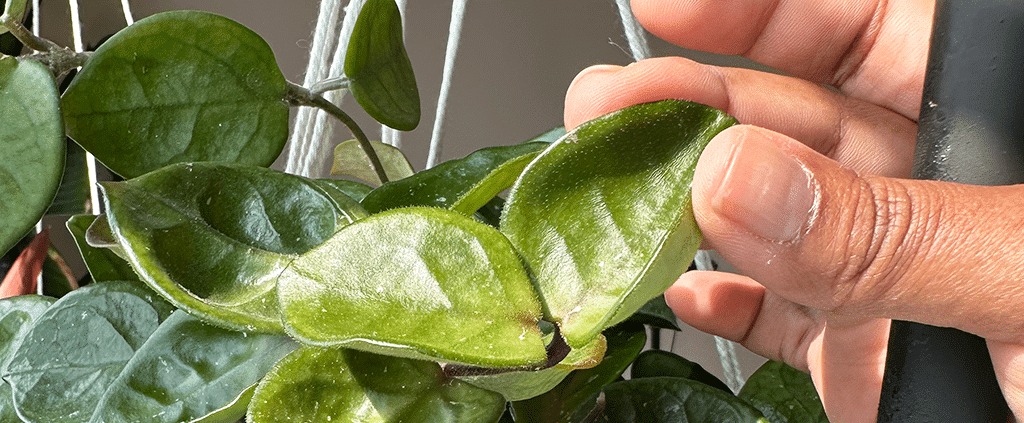
make sure your hoya gets lots of light – like, LOTS of light.
Not only are hoyas hardy plants, but hoyas are also tropicals, so they thrive in bright light. My hoyas that flower most frequently get a few hours of direct sunlight each day, and bright indirect light the rest of the day. In my experience it’s hard to give these plants too much light – if exposed to 6+ hours of direct light a day, they may even start to show the pretty patterns typical of a sun-stressed plant.

feed me, see more…flowers!
If you want a plant to put out new growth or blooms, it needs the nutrients to do so. Although you can of course use a tropical plant food the next time you water your hoya, I’ve had great luck fertilizing mine with the Miracle-Gro Ready-to-Use Orchid Plant Food Mist. Like orchids, hoyas are epiphytes. In the wild, epiphytic plants grow not in soil, but attached to other plants, and absorb water and nutrients from the air. Spraying plant food on in the form of a mist allows a hoya’s leaves to absorb those nutrients the same way they would in the wild.
#easypeasy

snapdragons
aka antirrhinums, dragon flowers, and dog flowers
Snapdragons are a beloved choice for cottage gardens and perennial flower beds, adding charm and beauty to any landscape. These flowers possess a unique charm with their dragon-like flower heads and a stunning range of colours including white, yellow, pink, orange, and purple.
variations
Tall snapdragons, Dwarf snapdragons, Twining snapdragons (climbing snapdragons), and Angelonia snapdragons.
light
full sun
For best blooming results, make sure they receive at least 6 hours of direct sunlight daily.
water + feeding
thirsty
Snapdragons are somewhat drought-tolerant and prefer a good drink followed by a period of dryness.
toxic
yes
While Snapdragons are safe for humans they can lead to an upset stomach for furry friends.
size
it depends
Snapdragons come in different sizes depending on the variation. On average, they grow between 1 and 3 feet tall. Dwarf varieties only reach up to 10 inches, while larger species can reach 4 feet.
pro tip
give them room to bloom
Snapdragons like to have a bit of personal space. Make sure to leave about 6 to 12 inches between each plant to provide ample space for them to expand and thrive. Plus, it can actually help prevent the spread of diseases. These aren’t wallflowers—they like a little room to show off their vibrant blooms!
fun fact
snap it open!
The name ‘Snapdragon’ comes from an old superstition that says if you hold the flower by the stem and squeeze it, its mouth will “snap” open and close. They may not actually snap at you, but it’s still a fun way to engage with these beautiful plants! So don’t be afraid to give them a gentle squeeze and watch their petals snap.

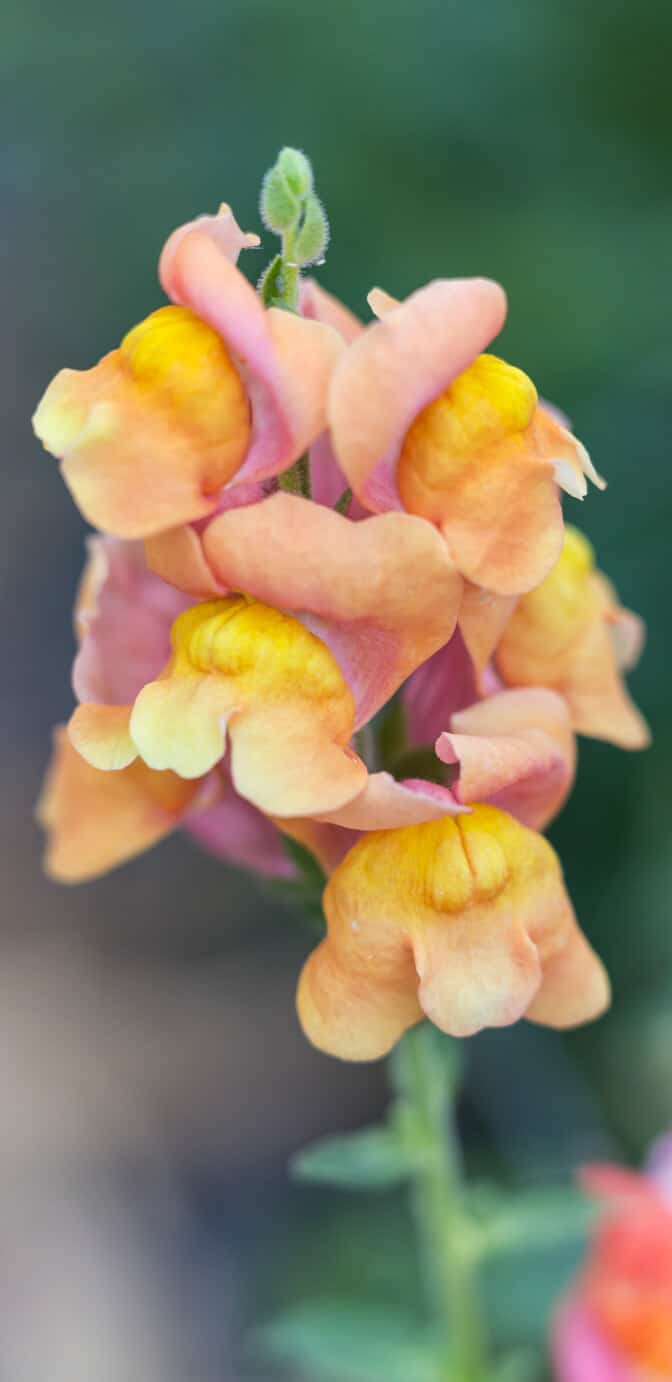
beyond the basics
-
soil and potting
Snapdragons thrive in nutrient-rich, well-draining soil like Miracle-Gro® Moisture Control® Garden Soil. For outdoor planting, choose a sunny spot with ample spacing of 6 to 12 inches. In containers, use a pot that is at least 12 inches deep and wide, providing the roots with enough space to expand and thrive. Also, make sure the pot has good drainage to keep those roots from getting waterlogged.
-
companion planting
Snapdragons are versatile plants that effortlessly blend into any garden. They complement summer blooms like petunias, lavender, and sunflowers, as well as aromatic herbs like rosemary and sage.
-
blooms
Different varieties of snapdragons have single, double, or frilly petals and come in many vibrant colours. The most common variations are tall snapdragons that feature flowers with broad petals on strong stems, dwarf snapdragons that boast delicate blooms in an array of colours on short stems, and double snapdragons which feature multiple rows of ruffled petals.
-
pest control
Snapdragons generally are resistant to pests, but it’s important to keep an eye out for aphids and thrips. If you happen to spot any of these pests, it’s recommended to employ natural methods such as using an insecticidal soap like Ortho® Bug B Gon® ECO Insecticidal Soap or rinsing the foliage thoroughly with a forceful stream of water to dislodge any potential invaders.

troubleshooting
-
why aren’t my snapdragons blooming enough?
Insufficient sunlight exposure or subpar fertility conditions. To ensure your Snapdragons thrive, ensure your plants receive a minimum of 6 hours of direct sunlight each day. To improve soil fertility, you can enhance it by incorporating a nutrient boost like Miracle-Gro® Water Soluble All Purpose Plant Food. This will enrich the environment for your plants and promote their growth. Also, to encourage the formation of new buds, try deadheading to clear up any withered blossoms.
-
why are my snapdragon’s leaves powdery?
Fungal disease. This tends to appear in warm and humid climates. To prevent and treat this condition, ensure adequate air circulation between plants by leaving sufficient space when planting, avoid wetting the foliage during watering sessions, and use fungicides if necessary.
-
why does it look like my snapdragons are wilting?
Over watering or under watering. Excess moisture can result in root rot, hindering your flowers’ ability to absorb essential nutrients. Conversely, a lack of moisture can cause your flowers to dry out or wither. To ensure optimal growth, carefully assess soil moisture levels and adjust watering practices accordingly.
-
why are my snapdragons falling over?
Insufficient sunlight. To address this, try moving the plant to a spot that ensures 6 hours of sunlight. Additionally, consider pruning the leggy stems and using supports such as stakes or trellises to help the stalks stand tall.
This plant’s been in the same soil since I got it years ago and is due for a repot. Although it hasn’t outgrown its pot, the soil is extremely dry and no longer retains the moisture the plant needs. So here’s how to repot a plant while changing out most of its soil!
here’s what you need to get started:
- your plant
- a nursery pot
- a quality potting mix (this ficus elastica is a tropical plant, so I’m using Miracle-Gro Tropical Potting Mix)
- a potting mat or tarp (optional)
- a shovel or soil scoop (optional)

step one.
The first step is to gently coax the plant out of its pot. I did this by laying to pot on its side and gently squeezing and rolling the soft plastic of the nursery pot. Then pull the plant out of the pot.

step two.
Using your fingers, begin to gently remove some of the old soil from the root ball.
Plants don’t particularly like having their roots disturbed (think about it: how often does someone come along and dig a plant up to tear apart its roots in the wild?) and being too rough can cause damage which can lead to root rot. You do want to remove some soil, though, so the roots can access the nutrients in the fresh new soil.
TLDR, gently remove as much soil as possible while doing as little damage to the roots as possible.

step three.
Grab the pot you’re planning to pot the plant in. The rule of thumb is to choose a pot that’s ~2 inches bigger than the root ball. (I decided to plant mine back in the original pot, as it was still an appropriate size, it was just the soil that needed changing.) Fill the bottom of the pot with a couple inches of soil. Then place your plant in and fill the sides and top with soil!
step four.
I like to wait a week or so after repotting before watering the plant. That way, hopefully, any root damage should form a callus and avoid root rot with the additional moisture.
#easypeasy
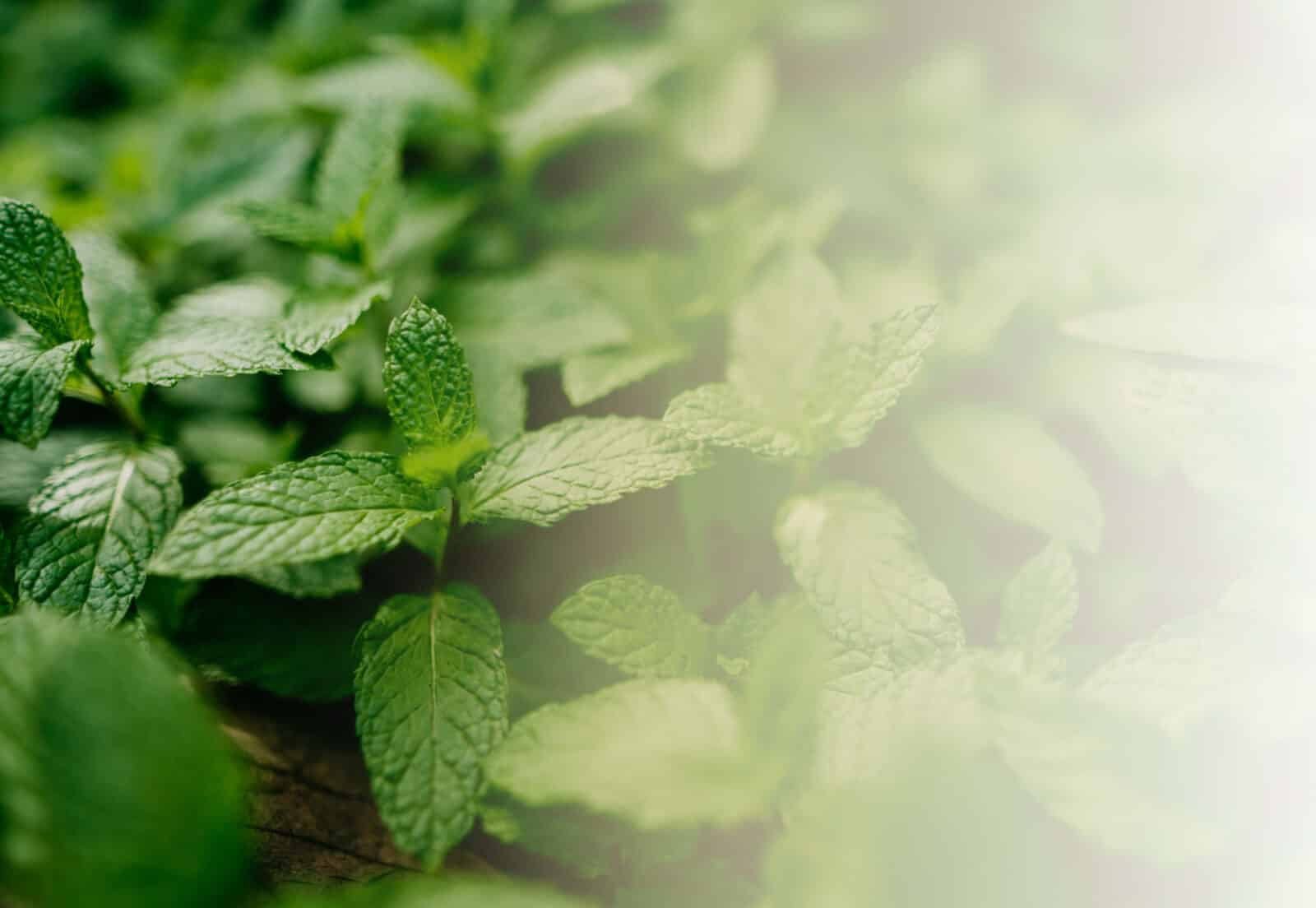
mint
aka mentha
Mint is an easy, fast-growing herb that is used in drink and food recipes. It is a perennial herb that grows little white and purple flowers. There are over 30 different variations of mint, but the most commonly grown is spearmint and peppermint.
variations
Apple/Pineapple Mint, Corsican Mint, Pennyroyal, Peppermint, Citrus Mint, Spearmint
light
full sun
If the soil is nice and moist, full sun is okay. Mint can also thrive in partial shade.
water + feeding
thirsty
Should be watered at least twice a week.
toxic
no
This plant is safe for animals to nibble on.
size
small to medium
Mint can grow to between 1 – 2 feet tall.
pro tip
An effective remedy for headaches
If you are prone to tension headaches, you can make a compress out of mint leaves for your forehead or rub peppermint oil on your temples.
fun fact
Ancient origins
Mint was used in ancient Greece, Rome, and Egypt

beyond the basics
-
soil + potting
Mint does not need to be fussed over which makes it perfect for first-time gardeners. When planting your mint consider using a well-draining soil that can help with moisture control, like Miracle-Gro® All Purpose Garden Soil. This soil helps to prevent from over- and under-watering your mint plant.
-
companion planting:
Luckily, mint is an easy herb to find companion plants for. You can take your pick of popular home garden veggies such as: carrots, cabbage, kale, tomatoes, bell peppers, beans and even zucchini.
-
harvesting
Frequent harvesting is important to keeping your mint flourishing. Young leaves have more flavour than older leaves. With this in mind, you can start harvesting your mint as soon as it comes up this spring.
-
pest control
If you see your mint plant drooping, there might be a pest problem. Common pests you might see with mint plants are aphids, mealy bugs, spider mites, or flea beetles. If you are seeing curling leaves or holes in your leaves, these are tell-tale signs of pests. Don’t worry, there is an easy fix. You can use a gentle insecticide like Ortho® Bug B Gon® ECO Insecticidal Soap Ready-To-Use to safely and quickly get rid of those little nuisances.


troubleshooting
-
What do I do with my mint once I harvest it?
You’ve got options.
Once you pick a few sprigs from your mint plant, you can keep them in water for a few days. It is best to use your mint while it is fresh, about 3-5 days. If you are looking to dry your mint leaves, cut them right before flowering and let the leave air dry. Once dry, store the dried mint in an air-tight container.
Or you can just pick the leaves from your mint plant as you need them.
-
Why is my mint looking leggy?
More sunlight. Most of the time, if your mint plant is looking thin and leggy it is lacking sunlight or water or nutrients. The best way to prevent mint from getting leggy is to make sure it is growing in a warm spot that gets lots of light. Keep it in a big pot with well-draining and nutrient rich soil.
-
Why is my mint turning crispy and brown?
Under-watering. This is easy to fix. Try watering your mint on a schedule, aiming for once or twice a week. Be sure to water under the leaves and close to the soil so you don’t damage the leaves.
-
How do I know if my mint is healthy?
Healthy, ready to use mint is a deep, rich green. If your mint is yellow and falling, it is likely due to its growing conditions. Keep your mint plant in full or partial sun, with a well-draining potting mix like Miracle-Gro® All Purpose Garden Soil. Make sure you water your mint whenever the top of the soil is dry, usually about twice a week.
Tired of plain-jane plant labels in your veggie garden? These illustrated plant markers are a fun way to add some colour and pizazz to your garden before your plants ever start to flower and bear fruit!

here’s what you need to get started:
- wooden plant markers ( possible alternatives: wooden spoons or paint stirring sticks)
- paint brushes
- acrylic paints (suggested: red, yellow, blue, green, black, white)
- pencil & eraser
- matte or gloss sealing spray
- plate or paint palette
- paint markers (optional)
- paper towel or cloth
- water

step one.
Using pencil, sketch out the basic shapes of the type of plant you want to label: an elongated oval for peppers, rounded triangles for strawberries, circles for tomatoes, and so on. Write out the name of the plant in pencil as well. Use your best handwriting or get creative with different writing styles!
step two.
Pour your desired paint colours onto your plate or palette. Use the colours you have to mix up any colours you’re missing: red and blue make purple, blue and yellow make green, and so on. You can also a tiny amount of black or white to your mixtures to darken or lighten them respectively.

step three.
Time to start painting! Choose a dark or light solid colour for the plant name, depending on the background you’re painting on. To paint the fruits, veggies, and flower illustrations begin with a solid base layer of paint and gradually add in additional layers for opacity and details. A white highlight on a pepper or various shades of red on a tomato go a long way to making your illustrations really pop!


step four.
Let paint dry thoroughly – ideally overnight – before erasing any stray pencil marks. Finish by spraying with sealing spray to preserve your designs through those summer rainstorms.

#easypeasy
There’s something magical about terrariums. They take up so little space, and yet, house an entire ecosystem within them. If you’re reading this article, you’ve likely seen countless Pinterest boards of beautiful, tiny terrarium creations made to resemble small towns, wild forests, or other stunning locales.
But while terrarium inspo-pics are fun to look at, they can also spark that dreaded impostor syndrome within us. The thought of “can I really make something like this?” holds so many of us back from even attempting to start.
The truth is: terrariums are much simpler to create than most people think! All you need are a few base ingredients to start, and the courage to get creative.
ready to make your own world within a glass jar?


Here’s what you’ll need:
- A good potting mix (for this project we recommend Miracle-Gro® Cactus, Palm and Succulent Potting Mix)
- Activated Charcoal
- Your choice of terrarium-friendly plants: like succulents, air plants or miniature cacti
- Pebbles for drainage
- A spray bottle for watering
- Battery operated mini string lights
- A glass container for your terrarium plants
- Decorative or polished stones
- Crystals, small gnomes, or other mini decorations you want to add

step 1: choose your terrarium “home”
Avant de commencer, réfléchissez au style de votre terrarium et au type de plantes que vous souhaitez y placer.
Les réponses à ces questions détermineront si vous devez opter pour un terrarium ouvert ou fermé.
Si vous souhaitez avoir des plantes tropicales qui se développent dans des conditions humides, un terrarium fermé est idéal. En revanche, si vous optez pour des petits cactus ou des plantes grasses, un terrarium ouvert est la meilleure solution.
step 2: build your base
Got your perfect terrarium container? Great! Now, the real fun begins.
Start by adding a 1-1.5 inch layer of pebbles, followed by a thin layer of charcoal. The pebbles act as drainage holes, while the charcoal helps reduce the amount of bad bacteria that might start developing as your plants grow.
Once you’re done, add about 2.5 inches of your potting mix. Make sure you have enough soil for your plants’ roots to fit.
step 3: add your plants
Remove your plants from their original pot. Gently massage their roots to get rid of excess soil, and create small holes in your terrarium for your plant roots before carefully placing them inside.
We recommend starting with the bigger plants

step 4: have fun with it!
Now comes the best part – decorating your terrarium.
You can add polished stones, crystals, small figurines, or any other miniature decorations to make your terrarium unique to you.
Bring out your inner child, and don’t hold back!
step 5: light it up
Carefully weave your string lights into your terrarium, making sure that they’re not getting in the way of your plants. Place your battery pack somewhere easily accessible.
Once you’re all done, turn on the lights – and watch your terrarium come to life.
Not only do string lights add a touch of mythical beauty to your creation, they also provide much needed artificial lighting to the plants inside.
step 6: feed your ecosystem
Terrariums need very little upkeep to stay alive and thriving. But the amount of water they require depends on the type of terrarium you have.
Water evaporates faster in open terrariums, so they typically require a few sprays of it every couple weeks. Closed terrariums, however, retain water for much longer, so you only need to water them about twice a year.
